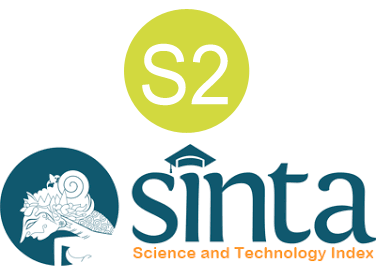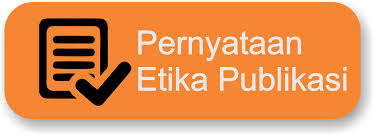Aktualisasi Catur Wi Berlandaskan Nilai Agama Hindu Pada Joged Bungbung di Kabupaten Gianyar
DOI:
https://doi.org/10.37329/jpah.v9i2.4047Keywords:
Actualization, Catur Wi, Joged Bungbung, Hindu ValuesAbstract
Globalization seems to have had a significant influence on Joged Bungbung, where art that initially displayed an aesthetic side is now turning towards an erotic side. Like Balinese dances in general, every dance generally has a standard called catur wi or four dance element guidelines, namely wirama, wiraga, wirupa and wirasa. This wi chess certainly contains Hindu religious values. Based on Hindu religious values, the art of Joged Bungbung should remain in the aesthetic corridor. The basic problem is that there has been no in-depth study regarding the elements of catur wi which contain Hindu religious values in the Joged Bungbung dance. The aim of this research is to become a reference in the development of the Joged Bungbung dance which is in accordance with Hindu religious values. Using a qualitative research methodology approach, researchers collected data, reduced data and presented data in descriptive form. Data collection was carried out using interviews, observations and document studies regarding the urgency and implementation of chess wi which is based on Hindu religious values in Gianyar district. The results of this research show the urgency of actualizing chess wi based on Hindu religious values, namely, the existence of ethics and aesthetics in the art of Joged Bungbung, secondly the role of Joged Bungbung art in social life, thirdly, joged art is a dancer's self-representation. The form of actualization of chess wi which is based on Hindu religious values contains religious values in the components of wiraga, wirama, wirasa and wirupa. The conclusion is that Gianyar still exists and maintains the art of jogging by adhering to the tenets of chess wi which are based on Hindu religious values.
References
Darmayasa, I. M. (2018). Bhagavad Gita. Denpasar: Yayasan Dharma Sthapanam.
Dewi, N. L. W. P. (2020). Makna Tarian Joged Bungbung Sebagai Identitas Baru Masyarakat Suku Bali Di Desa Kerta Buana, Kabupaten Kutai Karanegara. E-Jurnal ilmu Komunikasi, 6(1), 188-202.
Dewi, N. M. E. K. (2021). Siva Nataraja Perspektif Teo-Estetik. Jnanasiddhanta: Jurnal Teologi Hindu, 2(2), 17-26.
Dhika, I. P. G. J., Sudarsana, I. M., & Sukadana, I. W. (2022). Tari Joged Bumbung Pingit dalam Upacara Piodalan di Pura Dalem Sasih, Banjar Sasih Desa Adat Panjer, Kecamatan Denpasar Selatan (Nilai-nilai Pendidikan Seni Tari Keagamaan Hindu). Widyanatya, 4(1), 80-89.
Dibya, I. W. (2021). Panca Wi Lima Pedoman Dasar Tari Bali. Denpasar: Prasasti.
Firdaus, A. R. P., & Sadewo, F. X. S. (2023). Eksistensi Tari Thengul Di Era Global. Jurnal Budaya Etnika, 7(1), 3-11.
Hartatik, A., & Pratikno, A. S. (2022) Pudarnya Eksistensi Kesenian Tradisional Ludruk Akibat Globalisasi Budaya. Civis: Jurnal Ilmiah Ilmu Sosial dan Pendidikan, 12(2), 56-70.
Kiswara, K. A. T. (2023). Aktualisasi Konsep Pendidikan Kihajar Dewantoro Pada Tari Rejang Lilit Di Desa Tinggasari Kecamatan Busungbiu Kabupaten Buleleng (Persefekif Seni Tari Keagamaan Hindu). WIDYANATYA, 5(1), 37-45.
Laksemi, S. K. (2006). Taksu Dalam Kebudayaan Bali. Jurnal Dimensi Seni Rupa dan Desain, 4(1), 17-17.
Maulana, R., & Rahmatullailili, P. (2023) The Influence Of Globalization On The Existence Of Regional Culture. International Journal of Students Education, 2(1), 59-62.
Sarjiwo. (2018). Internalisasi Wirasa Dengan Olah Tubuh Bagi Pemeran Dalam Tari Gaya Yogyakarta.
Sintia, N. K., & Rudiarta, I. W. (2024). Estetika Hindu dalam Gerakan Sūrya Namaskāra. Jurnal Yoga Dan Kesehatan, 7(1), 11-28.
Subagiasta, I. K. (2006). Jenis Seni Wali Mengiringi Upacara Yadnya Yang dilaksanakan Oleh Umat Hindu di Bali. Jurnal Mudra, 9(2), 112-122.
Sugiartha, I. G. A. (2024). Etika Dalam Seni Pertunjukan Fenomena Joged Jaruh di Bali. Proseding Seminar Nasional Fakultas Pendidikan Universitas Hindu Indonesia.
Supartama, I. G. M. B., & Sukadana, I. W. (2020). Tari Bali: Tantangan Dan Solusi Di Era Globalisasi. Widyanatya, 2(1), 57-61.
Sudarmono, S. (2021). Pembangunan Modal Social. Bandung: Rtujuh Media Printing.
Triguna, I. B. G. Y., & Sutrisno, N. (2024). Transformasi Etika Hindu Dalam Trilogi Seni: Refleksi Kritis Demoralisasi Masyarakat Bali Dalam Berkesenian. Proseding Seminar Nasional Fakultas Pendidikan Universitas Hindu Indonesia.
Tim Penyusun. (2021). Buku Caracamuscaya dan Terjemahnanya. Jakarta: Dirjen Bimas Hindu Kemenag RI
Tim Penyusun. (2019). Sejarah Seni Pertunjukan KabupatenGianyar. Gianyar: Dinas Perindustrian dan Perdagangan Kabupaten Gianyar.
Winiantari, N. W., & Darmawan, I. P. A. (2022). Estetika Hindu Dalam Lontar Aji Ghurnita. Jurnal Jnanasiddhanta, 4(1), 21-30.
Wirawan, K. I. (2018). Taksu Dalam Dramatari Tari Calonarang Sebuah Kajian Estetika Hindu. Jurnal Widyadari, 19(1), 40-45.
Yasa, I. W. S. (2007). Memahami Taksu, Ekspresi dan Metodenya. Widya Darma: Denpasar.
Yosiana, M., & Wulandari, R. (2023). Komodifikasi Tubuh Perempuan Pada Tarian Joged Bumbung Bali di Youtube. Jurnal Ilmiah Multidisiplin, 2(4), 162-167.
Downloads
Published
How to Cite
Issue
Section
License
Copyright (c) 2025 Ida Ayu Gede Prayitna Dewi, Komang Dedi Diana, Luh Putu Wiwin Astari

This work is licensed under a Creative Commons Attribution-ShareAlike 4.0 International License.
An author who publishes in the Jurnal Penelitian Agama Hindu agrees to the following terms:
- Author retains the copyright and grants the journal the right of first publication of the work simultaneously licensed under the Creative Commons Attribution-ShareAlike 4.0 License that allows others to share the work with an acknowledgement of the work's authorship and initial publication in this journal
- Author is able to enter into separate, additional contractual arrangements for the non-exclusive distribution of the journal's published version of the work (e.g., post it to an institutional repository or publish it in a book) with the acknowledgement of its initial publication in this journal.
- Author is permitted and encouraged to post his/her work online (e.g., in institutional repositories or on their website) prior to and during the submission process, as it can lead to productive exchanges, as well as earlier and greater citation of the published work (See The Effect of Open Access).
Read more about the Creative Commons Attribution-ShareAlike 4.0 Licence here: https://creativecommons.org/licenses/by-sa/4.0/.








